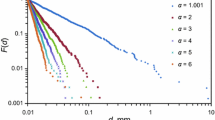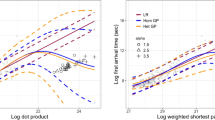Abstract
Analysis of the connectivity of a fracture network is an important component of the design, assessment and development of fracture-based reservoirs in geothermal, petroleum and groundwater resource applications. It is a useful means of characterising the flow pathways and the mechanical behaviours of reservoirs. An appropriate practical measure is required for connectivity characterisation because of the extreme complexity of fracture networks. In this paper, we propose the connectivity field (CF), as a useful measure to evaluate the spatial connectivity characteristics of fractures in a fracture network. The CF can be applied on both a particular realisation of a fracture network model (for deterministic evaluation) and on stochastic fracture network models using stochastic modelling and Monte Carlo simulations (for probabilistic evaluation with uncertainties). Two extensions are also proposed: the generalised connectivity field, a measure that is independent of support size, and the probabilistic connectivity field. Potential applications of the CF and its extensions are in determining the optimal location of an injection or production well so as to maximise reservoir performance and in determining potential flow pathways in fracture networks. The average CF map shows strong correlations with the \(X_{\mathrm{f}}\) and P21 measures. The relationships between the CF measures, the fracture intersection density and the fracture network connectivity index are also investigated.















Similar content being viewed by others
References
Alemanni A, Battaglia M, Bigi S, Borisova E, Campana A, Loizzo M, Lombardi S (2011) A three-dimensional representation of the fracture network of CO\(_{2}\) reservoir analogue (Latera caldera, central Italy). Energy Procedia 4:3582–3587
Allard D, HERESIM Group (1993) Geostatistics Troia’92. In: Soares A (ed) On the connectivity of two random set models: the truncated Gaussian and the Boolean. Kluwer Academic Publishers, Dordecht, pp 467–478
Baddeley A (2010) Analysing spatial point patterns in R. Workshop Notes. http://www.csiro.au/resources/Spatial-Point-Patterns-in-R. CSIRO, Australia, p 232
Balberg I (1986) Connectivity and conductivity in 2-D and 3-D fracture systems. In: Englman R, Jaeger Z (eds) Proceedings of the International Conference on Fragmentation, Form and Flow in Fractured Media, Ann Isr Phys Soc, vol 8, Adam Hilger, Bristol, England, pp 89–101
Berkowitz B (1995) Analysis of fracture network connectivity using percolation theory. Math Geol 27(4):467–483
Cacas MC, Daniel JM, Letouzey J (2001) Nested geological modelling of naturally fractured reservoirs. Pet Geosci 7:43–52
Committee on fracture characterization and fluid flow (CFCFF) (1996) Rock fracture and fluid flow. The National Academy Press, USA
Chilès JP, de Marsily G (1993) Flow and contaminant transport in fractured rock. In: Bear J, Tsang CF, de Marsily G (eds) Stochastic models of fracture systems and their use in flow and transport modelling. Academic Press, New York, pp 169–236
Diggle P (1983) Statistical analysis of spatial point patterns. Academic Press, Dublin, p 148
Dowd PA, Martin JA, Xu C, Fowell RJ, Mardia KV (2009) A three-dimensional fracture network data set for a block of granite. Int J Rock Mech Min Sci 46:811–818
Dowd PA, Xu C, Mardia KV, Fowell RJ (2007) A comparison of methods for the stochastic simulation of rock fractures. J Math Geol 39:697–714
Elfouly A (2000) Faults and fractures intersections delineation as a tool for groundwater detection using remote sensing and ground penetrating radar techniques at Saint Catherine area, Southern Sinai, Egypt. ICEHM2000. Cairo University, Egypt
Fadakar-A Y, Xu C, Dowd PA (2011) A general framework for fracture intersection analysis: algorithms and practical applications. In: Proceedings of the 2011 Australian Geothermal Energy conference, Geoscience Australia, pp 15–20
Fadakar-A Y, Dowd PA, Xu C (2013a) The RANSAC method for generating fracture networks from micro-seismic event data. J Math Geosci 45:207–224
Fadakar-A Y, Xu C, Dowd PA (2013b) Connectivity index and connectivity field towards fluid flow in fracture-based geothermal reservoirs. In: Proceedings of 38 Workshop on Geothermal Reservoir Engineering. Stanford University, Stanford, California, pp 417–427
Freeze RA (1975) A stochastic-conceptual analysis of one-dimensional groundwater flow in non-uniform homogeneous media. Water Resour Res 11(5):725–741
Ghaffari HO, Nasseri MHB, Young RP (2012) Fluid flow complexity in fracture networks: analysis with graph theory and LBM. Cornell University Library, http://arxiv.org/abs/1107.4918, p 9
Gringarten E (1997) Geometric modeling of fracture networks. PhD Thesis, Stanford University, USA, p 128
Hanano M (2004) Contribution of fractures to formation and production of geothermal resources. Renew Sustain Energy Rev 8:223–236
Hayashi K, Willis-Richards J, Hopkirk RJ, Niibori Y (1999) Numerical models of HDR geothermal reservoirs—a review of current thinking and progress. Geothermics 28:507–518
Hestir K, Long JC (1990) Analytical expressions for the permeability of random two-dimensional Poisson fracture networks based on regular lattice percolation and equivalent media theories. J Geophys Res 95(B13):21565–21581
Hoshen J, Kopelman R (1976) Percolation and cluster distribution, I: Cluster multiple labeling technique and critical concentration algorithm. Phys Rev B 14(8):3438–3445
Jimenez-Rodriguez R, Sitar N (2008) Influence of stochastic discontinuity network parameters on the formation of removable blocks in rock slopes. Rock Mech Rock Eng 41(4):563–585
Jing L (2003) A review of techniques, advances and outstanding issues in numerical modelling for rock mechanics and rock engineering. Int J Rock Mech Min Sci 40:283–353
Jing L, Stephansson O (2007) The basics of fracture system characterization-field mapping and stochastic simulations. Dev Geotech Eng 85:147–177
Karvounis D, Jenny P (2011) Modeling of flow and transport in enhanced geothermal systems. In: Proceedings of 36th Workshop on Geothermal Reservoir Engineering. Stanford University, Stanford, California, SGP-TR-191, p 8
Kvartsberg S (2010) Hydrogeological characterisation of a fracture network. MSc Thesis, Chalmers University of Technology, Sweden, p 95
La-Pointe PR, Hudson JA (1985) Characterization and interpretation of rock mass joint patterns, Geological Society of America, Special paper 199, Denver
Lee C, Yeh H, Lin H (2010) Modeling spatial fracture intensity as control on flow in fractured rock. Environ Earth Sci 63(6):1199–1211
Mardia KV, Nyirongo VB, Walder AN, Xu C, Dowd PA, Fowell RJ, Kent JT (2007) Markov chain Monte Carlo implementation of rock fracture modelling. J Math Geol 39:355–381
Mauldon M (1992) Relative probabilities of joint intersections. In: Tillerson JR, Wawersik WR (eds) Rock mechanics. Proceedings of the 33\(^{rd}\) U.S. Symposium, A.A. Balkema, location varies, pp 767–774
Mauldon M (1994) Intersection probabilities of impersistent joints. Int J Rock Mech Min Sci Geomech Abst 31(2):107–115
Michaelides K, Chappell A (2009) Connectivity as a concept for characterising hydrological behaviour. Hydrol Process 23:517–522. doi:10.1002/hyp.7214
MIT (2010) The future of geothermal energy. Technical Report, U.S. Government. http://mitei.mit.edu/publications/reports-studies/future-geothermal-energy, p 372
Nelson RA (2001) Geologic analysis of naturally fractured reservoirs. Gulf Professional Publishing, p 350
Pardo-Igúzquiza E, Dowd PA (2003) CONNEC3D: a computer program for connectivity analysis of 3D random set models. J Comput Geosci 29(6):775–785
Priest SD (1993) Discontinuity analysis for rock engineering. Chapman & Hall, London, p 473
Priest SD, Hudson JA (1981) Estimation of discontinuity spacing and trace length using scanline surveys. Int J Rock Mech Min Sci 18:183–197
Renard P, Allard D (2011) Connectivity metrics for subsurface flow and transport. Adv Water Resour. doi:10.1016/j.advwatres.2011.12.001
Robert C, Casella G (1999) Monte Carlo statistical methods. Springer, New York
Robinson PC (1983) Connectivity of fracture systems: a percolation theory approach. J Phys A 16:605–614
Sahimi M (1993) Flow phenomena in rocks: from continuum models to fractals, percolation, cellular automata, and simulated annealing. Rev Mod Phys 65(4):1393–1534
Seifollahi S, Dowd PA, Xu C, Fadakar-A Y (2013) A spatial clustering approach for stochastic fracture network modelling. J Rock Mech Rock Eng. doi:10.1007/s00603-013-0456-x
Singhal BB, Gupta RP (2010) Applied hydrogeology of fractured rocks. Springer, New York, p 408
Stauffer D, Aharony A (1992) Introduction to percolation theory. Taylor and Francis, London, p 181
Wen R, Sinding-Larsen R (1996) Geostatistics Wollongong 96. In: Baafi EY, Schofield NA (eds) Stochastic modeling and simulation of small faults by marked point processes and kriging. Kluwer Academic Publisher, Dordrecht, pp 398–413
Willis-Richards J, Wallroth T (1995) Approaches to the modelling of HDR reservoirs: a review. Geothermics 24(3):307–332
Xu C, Dowd PA (2010) A new computer code for discrete fracture network modelling. J Comput Geosci 36:292–301
Xu C, Dowd PA, Mardia KV, Fowell RJ (2006) A connectivity index for discrete fracture networks. J Math Geol 38(5):611–634
Zhang D (2002) Stochastic methods for flow in porous media. Academic Press, San Diego, p 350
Acknowledgments
The work described here was funded by Australian Research Council Discovery Project grant DP110104766. We also thank Professor Rafael Jimenez and two other anonymous reviewers for their constructive comments.
Author information
Authors and Affiliations
Corresponding author
Rights and permissions
About this article
Cite this article
Alghalandis, Y.F., Dowd, P.A. & Xu, C. Connectivity Field: a Measure for Characterising Fracture Networks. Math Geosci 47, 63–83 (2015). https://doi.org/10.1007/s11004-014-9520-7
Received:
Accepted:
Published:
Issue Date:
DOI: https://doi.org/10.1007/s11004-014-9520-7




